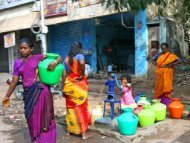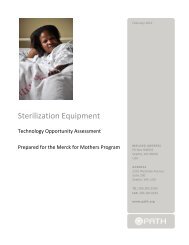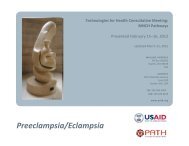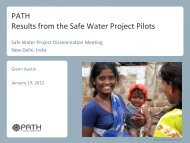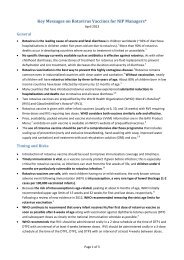Blood Loss Measurement - Path
Blood Loss Measurement - Path
Blood Loss Measurement - Path
Create successful ePaper yourself
Turn your PDF publications into a flip-book with our unique Google optimized e-Paper software.
February 2012<strong>Blood</strong> <strong>Loss</strong> <strong>Measurement</strong>Technology Opportunity AssessmentPrepared for the Merck for Mothers ProgramMAILING ADDRESSPO Box 900922Seattle, WA 98109USAADDRESS2201 Westlake AvenueSuite 200Seattle, WA, USATEL: 206.285.3500FAX: 206.285.6619www.path.org
Copyright © 2013, Program for Appropriate Technology in Health (PATH). All rights reserved.Cover photo credit: PATH/Amy MacIver.Funding for this technology assessment was provided by Merck.
<strong>Blood</strong> <strong>Loss</strong> <strong>Measurement</strong>SummaryDelayed diagnosis and poor management of postpartum hemorrhage (PPH) are associated with increasedmortality and morbidity. Accurate measurement of the amount of blood lost after childbirth helps toquickly diagnose life-threatening hemorrhage. Innovations in measuring blood loss could improve thetimely management of PPH.Statement of NeedObstetric hemorrhage is estimated to cause 25% of all maternal deaths and is the leading direct cause ofmaternal mortality worldwide. 1 Postpartum hemorrhage (PPH), defined as vaginal bleeding in excess of500 mL after delivery, is generally considered to account for a majority of the cases of obstetrichemorrhage, occurs in over 10% of all births, and is associated with a 1% case fatality rate. 2Although active management of the third stage of labor can prevent up to 60% of PPH cases, PPHcontinues to have a devastating impact on women in resource-poor settings where home births arecommon and hospitals or health facilities are often inaccessible. Obstetric hemorrhage accounts for 34% ofmaternal deaths in Africa, 31% in Asia, and 21% in Latin America and the Caribbean, while only 13% ofmaternal deaths in developed countries are due to hemorrhage. Women who survive PPH can suffer fromanemia postpartum. 3Most births and maternal deaths occur in Africa and Asia where home deliveries are common,infrastructure and transportation are limited, and birth attendants are scarce or inadequately prepared toprevent and treat PPH. 4 In such settings hemorrhage accounts for more than 30% of maternal deaths. 1 TheUnited Nation’s fifth Millennium Development Goal, to reduce 75% of maternal mortality by 2015,cannot be reached without addressing PPH. 5,6Several factors influence PPH rates, such as how blood loss is measured at delivery, how the third stage oflabor is managed (i.e., active management of the third stage of labor), or how obstetric interventions arecarried out (i.e., episiotomy). 7 Delayed diagnosis and poor management of PPH are associated withincreased maternal mortality and morbidity. Clinicians continue to rely on visual assessment to determinethe volume of postpartum blood loss even though studies have repeatedly shown visual estimates to beinaccurate (overestimating blood loss at low volumes and underestimating blood loss at high volumes).Technologies that can help women and clinicians estimate postpartum blood loss more accurately couldimprove management of PPH, reduce cases of severe PPH (blood loss greater than 1,000 mL), and reduce1
morbidity and mortality due to PPH. Methods to estimate postpartum blood loss include direct collectionof blood in pans, gravimetric measurement of sponges (weighed before and after use), or blood collectiondrapes or mats. An ideal technology or method should estimate blood loss in real time, provide an accurateestimation of threshold volumes, permit early diagnosis of PPH (at least 500 to 1,000 mL of blood loss),have a high specificity and sensitivity, be practical and easy to use, be low cost, and require minimalequipment.Technology Solutions LandscapeOver the years, different methods have been used to estimate blood loss. Several quantitative methods aredescribed below, including visual assessment, direct methods of measurement, and laboratory-basedmethods of measurement. 8Visual assessmentThe standard method of observation used for the visual estimation of blood loss is relativelystraightforward and requires no expenditure. Despite its inaccuracy and variation from one caregiver to thenext, birth attendants correlate it with clinical signs. The major advantage of this method is that it is a realtimeassessment and enables the birth attendant to correlate findings, on an individualized basis, with theclinical presentation. However, significant differences between clinical estimates and actual measurementshave been consistently demonstrated in several studies. A common error is underestimation of blood loss,with an average error of 46%, when estimates at the time of delivery are compared with more precisemeasurements. 9 When losses are large, they are most often underestimated, and smaller losses tend to beoverestimated.Direct collection of bloodBedpan and standard measuring jar: This approach was used in the World Health Organization (WHO)multicenter, randomized trial of misoprostol in the active management of the third stage of labor. In thistrial, blood loss was measured from the time of delivery until the mother was transferred to postnatal care.This period was generally up to one hour postpartum. At that time, the collected blood was poured into astandard measuring jar provided by WHO and its volume measured. Immediately after the cord wasclamped and cut, the blood collection was started by passing a flat bedpan under the buttocks of a womandelivering in a bed or putting in place an unsoiled sheet for a woman delivering on a delivery table. Theerrors in estimating blood loss arise from failure to collect or note all the blood in the stained linen,incomplete extraction from the collection device, ignoring maternal blood within the placenta(approximately 153 mL), confusion related to the mixing of blood contaminated with amniotic fluid andurine, and technical inaccuracies associated with the transfer of the collected blood to a measuring device.Rubberized blood mat (Bangladesh): The International Centre for Diarrhoeal Disease Research,Bangladesh developed a rubberized blood mat which when saturated, is indicative that a woman ishemorrhaging. The mat holds approximately 500 mL of blood, with flowered plastic on one side and2
ubber on the other side. The mat holds a maximum of 500 mL of blood, at which point the mat will beginto leak onto plastic or onto the floor, signaling PPH. In a project implemented by <strong>Path</strong>finder InternationalBangladesh, each pregnant woman received a PPH bag, consisting of a rubberized blood mat, misoprostoltablets, and a clean delivery kit at 32 weeks gestational age. The mat was found to be well liked andutilized by communities in Bangladesh. In the fall of 2010, Dr. Md Abdul Quaiyum, developer of the mat,received a Grand Challenges in Global Health grant to enable further refinement of the mat to abiodegradable form. 10 This development would be important as medical waste is a challenge in manydeveloping-country settings.Kelly’s pad (India): With funding from the John D. and Catherine T. MacArthur Foundation and<strong>Path</strong>finder International, the Continuum of Care project was implemented in India using a rubberized mat,called a Kelly’s pad, to measure blood loss. The Kelly’s pad is a simple medical device to funnel blood toa collection device in order to help detect PPH. The device is widely used in India, though not elsewhere.The Kelly’s pad funnels blood into a calibrated collection bowl which has a hemorrhage alert line at 500mL. The pad is washable and sterilizable, making it far more cost-effective than a plastic collection drape.Kangas (Tanzania): A study in Tanzania found that two kangas (large pieces of African cloth) provided anapproximate measure of PPH; when the two cloths were saturated with blood, they held approximately 500mL of blood. 11 The advantage of this method is the use of locally available measures that do not requiremanufacturing, distribution, or waste disposal.<strong>Blood</strong> drape (Nigeria): With funding from the John D. and Catherine T. MacArthur Foundation,<strong>Path</strong>finder International implemented the Continuum of Care project using a blood drape. The blood drapeis a plastic sheet that is placed under the woman and siphons the blood into a calibrated measuring pocketon the sheet. The sheet is decontaminated and then disposed of as medical waste or incinerated after use.Stacie Geller with the University of Chicago and Richard Derman with the University of Kansas are theprincipal investigators and developers of the BRASS-V ® drape. 12Gravimetric method: This method involves weighing sponges before and after use. The difference inweight provides a rough estimate of blood loss. The gravimetric method requires the weighing of materialssuch as soaked pads on a scale and subtracting the known weights of these materials to determine theblood loss. Inaccuracies can arise at several steps in this procedure, including lack of internationalstandardization of size and weight of gauze, sponges, and pads.Laboratory-based methods of measurementAlkaline hematin method/Acid hematin method: Another direct method of blood loss measurement is basedon mixing collected blood with a standardized solution which converts hemoglobin to acid hematin orcyanmethemoglobin. This in turn can be measured by a spectrophotometer or colorimeter.3
Spectrophotometric analysis can be performed by the methods described below: 13-151. Preparation of standard: 2 mL of peripheral blood are collected pre-delivery. The blood standard isprepared with 0.1 mL of the patient’s peripheral blood in 9.9 mL of 5% sodium hydroxide solution.The optical density (OD) is read at 550 nm after 30 minutes.2. Preparation of sample: The collected sample is added to 2 L of 5% sodium hydroxide and left to standfor 15 minutes. One mL of the filtrate is diluted 10 times in 5% sodium hydroxide and left to stand foranother 15 minutes. The OD is read with a spectrophotometer at 550 nm at 30 minutes after theaddition of sodium hydroxide to the sample.3. Calculations: OD sample × 2,000 mL × 10/OD blood standard × 100 = blood loss volume.Gap AnalysisCurrently, although there are no donors or projects with a $1 million investment in any of the abovementionedtechnologies, there are many key stakeholders involved in the process of implementing bloodloss measurement initiatives. These include patients, traditional birth attendants, health care providers,governments, funding sources, WHO, institutions specialized in research and implementation of methods,international and national nongovernmental organizations working in health fields, and manufacturers.WHO recommends that blood loss and other clinical parameters after childbirth should be closelymonitored. 16 According to WHO, there is insufficient evidence at present to recommend quantification ofblood loss over clinical estimation. Thus, WHO has identified the following priority research areas:Define the quantity of blood loss that should be the marker for diagnosis of PPH (blood loss greaterthan 500 mL) and severe PPH (blood loss greater than 1,000 mL).Determine the role of quantifying blood loss in altering (or improving) clinical outcomes for themother and her baby.Identify clinical consequences of blood loss that are of greatest value for the diagnosis and treatmentof PPH.Most of the technologies used to indirectly measure blood loss do not provide a real-time assessment orare difficult to implement in low-resource countries due to requirements for sophisticated laboratoryequipment.Among the quantitative technologies for blood loss measurement, the rubberized blood mat used inBangladesh is the most promising in terms of its simplicity, low cost, and capacity to identify PPH quickly,especially in home deliveries. The rubberized mat was acceptable and well liked in selected communitiesin Bangladesh. 164
Investment OpportunityThe core investment for the rubberized mat should include designing a plan for introduction at the countrylevel, identifying the health service providers who can use it, designing a guideline for its use or adapting itto existing guidelines, and developing a strategy to measure impact.To understand impact and cost-effectiveness of the rubberized blood mat, operations research inrepresentative countries and settings in sub-Saharan Africa and South Asia will be needed to recommendthe use of services and evaluate maternal and perinatal outcomes from PPH. Careful documentation ofimplementation, disruptions, sustainability, lessons learned, and financial and service costs will helpinform scale-up decision-making.In addition, feedback should be collected from women, family members, providers, and managers onacceptability and perceptions of quality of care. These data should also inform scale-up decision-making.Finally, this technology can effectively be incorporated into regional manufacturing as long asstandardized and verifiable design specifications can be developed. Thus, PATH recommends investmentin identifying the feasibility of regional manufacturing and also research and development of standardizedproduct specifications.5
References1. Khan KS, Wojdyla D, Say L, Gülmezoglu AM, Van Look PFA. WHO analysis of causes of maternaldeath: a systematic review. The Lancet. 2006; 367(9516):1066–1074.2. World Health Organization (WHO). MPS Technical Update: Prevention of Postpartum Haemorrhageby Active Management of the Third Stage of Labour. Geneva: WHO; 2006.3. AbouZahr C. Global burden of maternal death and disability. British Medical Bulletin. 2003; 67:1–11.4. WHO, United Nations Children’s Fund (UNICEF), United Nations Population Fund (UNFPA), TheWorld Bank. Maternal Mortality in 2005: Estimates Developed by WHO, UNICEF, UNFPA, and theWorld Bank. Geneva: WHO; 2005.5. United Nations. The Millennium Development Goals Report 2008. New York: United Nations; 2008.6. International Federation of Gynaecology and Obstetrics (FIGO), International Confederation ofMidwives (ICM). Prevention and Treatment of Post-partum Haemorrhage: New Advances for LowResource Settings. Joint Statement: International Confederation of Midwives (ICM), InternationalFederation of Gynaecology and Obstetrics (FIGO). The Hague: ICM; London: FIGO; 2006. Available at:http://www.pphprevention.org/files/FIGO-ICM_Statement_November2006_Final.pdf.7. WHO, Department of Reproductive Health and Research. Managing Complications in Pregnancy andChildbirth: A Guide for Midwives and Doctors. Geneva: WHO; 2007.8. Kodkany BS, Derman RJ. Pitfalls in assessing blood loss and decision to transfer. In: B-Lynch C, KeithLG, Lalonde AB, Karoshi M, eds. A Textbook of Postpartum Hemorrhage. Dumfriesshire, UK: SapiensPublishing; 2006.9. Brant HA. Precise estimation of postpartum hemorrhage: Difficulties and importance. British MedicalJournal. 1967; 1(5537):398–400.10. ICDDR,B Receives $100,000 Grand Challenges Explorations Grant for Innovative Global HealthResearch [press release]. Dhaka, Bangladesh: The International Centre for Diarrhoeal Disease Research,Bangladesh; November 10, 2010. Available at: http://www.icddrb.org/media-centre/mediareleases/cat_view/60-media-releases.11. Prata N, Mbaruku G, Campbell M, Potts M, Vahidnia F. Controlling postpartum hemorrhage afterhome births in Tanzania. International Journal of Gynaecology and Obstetrics. 2005; 90(1):51–55.12. Patel A, Goudar S, Geller S, et al. Drape estimation vs. visual assessment for estimating postpartumhemorrhage. Int J Gynaecol Obstet. 2006; 93:220‒224.6
13. Newton M, Mosey LM, Egli GE, Gifford WB, Hull CT. <strong>Blood</strong> loss during and immediately afterdelivery. Obstet Gynecol. 1961;17:9–18.14. Chua S, Ho LM, Vanaja K, Nordstrom L, Roy AC, Arulkumaran S. Validation of a laboratory methodof measuring postpartum blood loss. Gynecol Obstet Invest. 1998;46(1):31–33.15. Razvi K, Chua S, Arulkumaran S, Ratnam SS. A comparison between visual estimation andlaboratory determination of blood loss during the third stage of labour. Aust N Z J Obstet Gynaecol. 1996;36(2):152–154.16. WHO. WHO Guidelines for the Management of Postpartum Haemorrhage and Retained Placenta.Geneva: WHO; 2009.7



